Watch seventh graders share news literacy skills at a holiday dinner table
The holidays are a time to be together with loved ones, but conversations can get contentious if the topic turns to falsehoods circulating on social media or elsewhere. Luckily, the seventh-grade students at North Salem Middle/High School in New York know how to keep the mood civil around the dinner table by relying on news literacy skills.
In a segment for CBS Mornings Plus, students in educator Cynthia Sandler’s media literacy class set a mock dinner table and gathered around a blow-up turkey to model how to listen with empathy, share verified information and separate fact from opinion – without starting an argument.
“Classrooms are a microcosm of society,” Sandler said. “What we can simulate in a class – listening, questioning, talking with one another, respecting one another – that is what is possible in society.”
Sandler, a media specialist, uses resources from the News Literacy Project to teach her lessons. The North Salem Central District is an alumni member of NLP’s News Literacy District Fellowship program, which provides training and support for school systems to implement their own news literacy curriculum.
Watch the full segment here. Check out the News Literacy Project’s resources for how to speak up without starting a showdown this holiday season here.
Educators tell New York Times how News Literacy Project tools help students learn
The New York Times asked educators how they helped their students stay savvy when it comes to reading the news. In response, several librarians named the News Literacy Project resources that let them create “informative and timely” lessons that guide students in recognizing credible sources.
Says one: “My students have been very receptive to and interested in media literacy.”
Read the New York Times piece here.
Scripps News showcases News Literacy Project study on teen media habits with classroom visit
Some 8 in 10 teens say they tend to believe one or more conspiracy theories they see online, according to a new study from the News Literacy Project.
“Anyone who’s worried about our democratic system, our civic dialog, education, or even the future of journalism, the future of media, should really be concerned,” notes Charles Salter, CEO and President of NLP.
But the study also shows positive associations with media literacy instruction. As one teacher in this article notes, NLP lessons help students “sift through the murky online marketplace of misinformation.”
Watch the Scripps News piece here.
Education Week on NLP study: Teens lean toward conspiracies – and want news literacy lessons
Teens are “inheriting the largest, most complex, most frenetic information environment in human history,” notes Peter Adams, the News Literacy Project’s Senior Vice President of Research and Design, in an interview with Education Week about the findings of a new study by NLP. That might be why 81% of teens who see conspiracy theories on social media say they believe at least one of them. But the survey also showed promise: 94% of teens said media literacy should be taught in school.
Read the Education Week piece here. The study, News Literacy in America: A survey of teen information attitudes, habits & skills, is available here.
Adams on KCBS Radio: Tailor your algorithm by following credible news organizations
KCBS Radio’s Ask an Expert series featured Peter Adams, the News Literacy Project’s Senior Vice President of Research and Design, in an interview that highlighted findings from NLP’s new study of teens and their media habits. The news anchors focused on the encouraging news that most teens wanted media literacy lessons in schools. Adams also offered advice for adults: Seek standards-based sources and multiple credible reports.
Listen to the KCBS interview here. The study, News Literacy in America: A survey of teen information attitudes, habits & skills, is available here.
News Literacy Project CEO tells USA Today: Schools should require teaching news literacy
Educators who have taught news literacy skills in their classes — how to spot biases, recognize ads versus news, and more — say their students find the courses invaluable. But few states require that media literacy be taught. News Literacy Project President and CEO Charles Salter notes why some states hesitate, even as educators who teach those skills praise the results.
Read the USA Today story here. Learn more about the News Literacy Project’s strategic approach to systemic change in the U.S. education system here.
Beverly Hills Courier announces its school district earned a News Literacy Project fellowship
Beverly Hills Unified School District in California has been accepted to the News Literacy Project District Fellowship Program, a two-year grant that provides funding, professional support and resources for school systems that want to design and implement plans to teach news literacy. Beverly Hills joins school districts across the country, including the nearby Los Angeles Unified School District. NLP’s Ebonee Otoo, Senior Vice President of Educator Engagement, explains that the program’s goal is for students to graduate from high school skilled in news literacy.
Read the article in the Beverly Hills Courier here. Read more about the district fellowship here.
‘It’s really muddying the waters’: NLP’s Covington on pink slime
Pink slime outlets pose as legitimate local news organizations, but they lack the ethical standards of trustworthy journalism. In a recent mLive article, Hannah Covington, NLP’s senior director of education content, weighed in on a pink slime newspaper circulating in Michigan and emphasized the need for news literacy skills to detect unreliable stories, especially ahead of this year’s elections.
“These websites are often paid for by political groups, and they’re often pushing partisan politics and advocacy stories that are making a policy, candidate or party look good,” Covington said.
Read the full article here.
New Jersey station highlights classroom using NLP resources
A recent NJ Spotlight News segment featured a middle school class at Princeton Montessori School in New Jersey, where News Literacy Project Ambassador Aish Sami uses free educator resources from NLP to teach a media literacy course.
“My hope and dreams for the students when they walk out of the classroom is that they feel empowered to analyze information,” Sami said.
Watch the full segment here.
NLP defines news literacy for Encyclopedia Britannica entry
In a recent update to Encyclopedia Britannica, Pamela Brunskill, the News Literacy Project’s senior director of education, broke down the meaning of news literacy. She detailed how to assess different types of information, understand the First Amendment, detect misinformation and practice civic responsibility.
“News literacy teaches people how to think critically about timely issues and sources of information, not what to think,” Brunskill wrote. “It helps foster healthy skepticism while avoiding cynical distrust of all news and information.”
Read the full entry here.
‘It’s really our responsibility’: Los Angeles NPR station speaks with NLP
Students need to learn news literacy skills so they can navigate our complicated information landscape and avoid misinformation, said Ebonee Otoo, NLP’s senior vice president of educator engagement, in a recent interview with L.A. NPR station KCRW.
California recently joined a growing number of states requiring media literacy instruction in schools. Otoo explained what the new requirement will mean for students, why it’s important to include media literacy instruction across subjects like math and science, and the challenges young people face when it comes to navigating our complicated information landscape.
“It’s really our responsibility to make sure that we’re teaching these skills to young people so they can participate in civic life,” Otoo said.
Brunskill’s commentary featured in The Horn Book Magazine
The November-December issue of The Horn Book Magazine, a noted publication in the field of children’s literature, features a piece by Pam Brunskill, senior manager of education design, on teaching news literacy across grades and subject areas.
Library of Congress honors News Literacy Project with its highest award
Rubenstein Prize recognizes efforts to improve literacy in the U.S. or abroad
NLP today received the highest honor from the Library of Congress Literacy Awards Program, the David M. Rubenstein Prize, in recognition of NLP’s outstanding efforts to help people of all ages identify misinformation and help stop its spread.
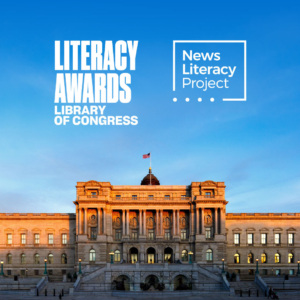 The awards are given annually on Sept. 8, which UNESCO has designated as International Literacy Day. The David M. Rubenstein Prize goes to an organization that has shown an “exceptional and sustained” commitment to advancing literacy while meeting “the highest standards of excellence in its operations and services.” Past awardees include Dolly Parton’s Imagination Library and Reading is Fundamental. NLP, a national nonpartisan education nonprofit, is the leading provider of news literacy education, offering free resources, tools and programs for educators and the public.
The awards are given annually on Sept. 8, which UNESCO has designated as International Literacy Day. The David M. Rubenstein Prize goes to an organization that has shown an “exceptional and sustained” commitment to advancing literacy while meeting “the highest standards of excellence in its operations and services.” Past awardees include Dolly Parton’s Imagination Library and Reading is Fundamental. NLP, a national nonpartisan education nonprofit, is the leading provider of news literacy education, offering free resources, tools and programs for educators and the public.
“The News Literacy Project is committed to ensuring a future founded on facts. The David M. Rubenstein Prize is a testament to the real, measurable impact of our programs. We are honored to receive this recognition from the Library of Congress,” said Charles Salter, president and CEO of NLP.
About the award
Established in 2013 and generously supported by philanthropist David M. Rubenstein, the Library of Congress Literacy Awards Program recognizes organizations that provide exemplary, innovative, sustainable and replicable strategies to promote literacy and reading. The Literacy Awards also include an American Prize and International Prize. Up to 15 organizations each year are named Successful Practices Honorees. For additional information about the awards and previous winners, as well as an interactive program map, visit the Library of Congress website.
Back to school with NLP and TIME for Kids
The News Literacy Project and TIME for Kids are teaming up this school year to bring educators seven weeks of news literacy resources and lessons. From September through mid-October, the upper elementary editions of the TIME for Kids teacher’s guide will feature classroom-ready materials that highlight the magazine’s journalism and NLP’s free resources.
Intended for grades 3 – 6, the lessons explore how to distinguish between facts and opinions; identify different types and purposes of information, like advertising and news; recognize the standards of quality journalism, and more. Each lesson builds foundational news literacy skills and provides opportunities for students to apply those skills through rich discussion prompts, collaborative group activities and challenging independent work. NLP’s Hannah Covington and Pam Brunskill co-created the materials along with Candace Dipsey of TIME for Kids. See the whole unit at ti.me/MediaLitUnit.
“This is an exciting collaboration that brings together the expertise of the News Literacy Project and TIME for Kids educators, whom we know understand the importance of teaching students how to identify credible sources of news and information,” said Peter Adams, NLP’s senior vice president of research and design.
To help educators take advantage of these and other instructional resources, TIME for Kids will offer a 20% discount to members of NLP’s NewsLitNation®, a free member community of news literacy education practitioners. Educators can join NewsLitNation now to take advantage of this offer. Members will also be entered into a drawing for a free classroom subscription to TIME for Kids, provided by the magazine. More details about how to enter and how to take advantage of the discount offer will be shared soon with the NewsLitNation community.
About TIME for Kids
Built on TIME’s long legacy, TIME for Kids has been a trusted news source for nearly 30 years, publishing a weekly current events magazine for kids during the school year as well as expanding into a global multi-channel education brand.
TIME for Kids builds the critical reading skills kids need to succeed in the information era. An annual subscription helps young readers better understand our complex world, and nurtures them to become informed, active citizens.
Deterring violence through news literacy in South Central Pennsylvania
Something unusual is happening in a cluster of South Central Pennsylvania counties: Despite today’s divisive climate, people from different ideological, racial and generational backgrounds are coming together to solve some of their community’s most pressing problems.
They’re doing it, partly, by becoming more news-literate.
Led by Urban Rural Action, a nonprofit dedicated to bringing people together across divides to address common challenges, a group of more than two dozen concerned community members will work collaboratively over the next 18 months to take action to deter targeted violence in their counties. Urban Rural Action calls the participants “Uniters.”
As part of the program, the News Literacy Project will present a series of training events to help communities learn to identify credible news sources, spot misinformation and stop its spread. NLP will also work with local partners to host four training sessions through the spring for community members across Pennsylvania.
The group kicked off its work in Gettysburg this winter and will continue meeting, learning and working with each other through August 2024. Participants come from Adams, Franklin, Dauphin and York counties — areas that were selected because independent risk assessments suggest they are at high risk for acts of targeted violence. Participants were chosen through an application process to ensure a group of diverse viewpoints and experiences.
What does news literacy have to do with preventing violence? Plenty, said Joe Bubman, the founder and executive director of Urban Rural Action.
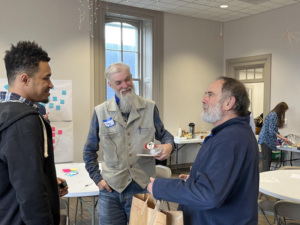
Bubman said a significant part of his organization’s work centers on promoting constructive dialogue among groups that don’t often interact. Getting those conversations started isn’t easy, with skeptical participants often asking, “How can you dialogue with those people when we can’t even agree on facts?” Bubman said.
“We think that has to do with misinformation,” he added. “If you’re going to have more constructive conversations, it’s going to help if community members are better equipped with news literacy skills.”
Kira Hamman, senior director of Urban Rural Action, added that consuming misinformation can be a risk factor that contributes to people carrying out acts of targeted violence. The group defines targeted violence as physical violence aimed at people or groups because of their perceived identity or affiliation; it is intended to intimidate, coerce or bring attention to the perpetrator’s grievance.
So, on a recent Saturday afternoon, a group of about 30 people filed into a community center in Chambersburg, Pennsylvania, to learn how to be more news-literate and prevent the spread of misinformation. DeMario Phipps-Smith, NLP’s senior manager of community learning, explained to the group how to tell the difference between information meant to persuade versus inform. He gave tips for analyzing news for credibility, like looking for multiple sources quoted or cited in stories. Together, the group analyzed headlines and social media posts to spot biased language.
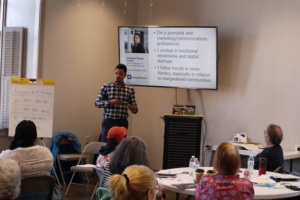
Phipps-Smith said one of the biggest takeaways participants shared was the need to check their own biases, and many realized how easy it is to get trapped in information bubbles that reinforce existing beliefs.
Despite the thorny issues tackled in previous sessions, Phipps-Smith said that the participants concluded that their conversations about misinformation had been the most charged.
“They were like, ‘Maybe that’s a sign,’” he said. “I think it opened people’s eyes to the misinformation crisis and just how important it is to have conversations with people who think differently than you.”
Mark World Press Freedom Day with news literacy resources
Today marks 30 years since the United Nations General Assembly proclaimed World Press Freedom Day to commemorate the Declaration of Windhoek, a statement of free press principles issued in 1991 by African journalists.
On the 30th anniversary of the designation, the U.N. is calling out threats to press freedoms around the world, including the proliferation of disinformation and misinformation, and underscoring the foundational right of free speech for all. “The right to freedom of expression, enshrined in Article 19 of the Universal Declaration of Human Rights, is a prerequisite and a driver to the enjoyment of all other human rights,” according to the U.N.
But violence and intimidation directed at journalists continue to threaten their ability to do this important work. In March Russia arrested Wall Street Journal reporter Evan Gershkovich and detained him on false charges of espionage. The nonprofit organization Reporters Without Borders (also known as Reporters Sans Frontières, or RSF) monitors press freedoms in 190 nations and regions. Each year it releases its press freedom index, and this year the United States fell to 45th place, down three spots from 2022.
Every year, World Press Freedom Day serves as a reminder for governments to respect their commitment to press freedom, a time of reflection for journalists and other media professionals, and an opportunity for the public to recognize the impact these freedoms on their lives.
Press freedom and news literacy
And an understanding of press freedom is essential to news literacy. To mark the day, NLP is sharing a suite of free resources for educators and the public to enhance the appreciation of press freedoms and free speech and to highlight the need for continued vigilance to protect these rights.
For educators
- Explore the Checkology® virtual classroom lessons “Press Freedoms Around the World”and “The First Amendment” as well as these related lessons: “Democracy’s Watchdog,” and “Citizen Watchdogs.”
- Test your students’ knowledge with this Checkology challenge: Know your rights: What freedoms does the First Amendment protect?
- Download this poster about the five freedoms protected by the First Amendment.
- Discuss recent items from The Sift® newsletter for educators, including, Russia’s arrest and detainment of Wall Street Journal reporter Even Gershkovich.
- An explore Dig Deeper classroom material: What press freedom challenges do journalists face around the world?, the 2022 World Press Freedom Index: What are the effects of news and information chaos? and Two journalists win the Nobel Peace Prize. Why is this significant?
For all
- Test your knowledge with our quiz, So, what’s the First Amendment?
- Check out the results of a survey of Americans’ knowledge of and appreciation for the First Amendment.
- Learn about the United States’ ranking in the World Press Freedom Index. It might surprise you!
- On May 3, proclaim your support for freedom of speech on social media by sharing @newslitproject posts or writing your own posts and using #PressFreedom and #WPFD2023 hashtags.
Understanding Black History Month is essential news literacy
The expansive legacy of Black History Month is rooted in the celebration and upliftment of African American history, culture and perseverance through unspeakable adversity. It is also deeply intertwined with our mission here at The News Literacy Project to solidify a future founded on facts. First established in 1926 by Carter G. Woodson, Black History Month began as Negro History Week, coinciding with the birthdays of Abraham Lincoln and Frederick Douglass.
Woodson knew first-hand the power of credible information as a transformational tool. As a Black man and the direct descendant of former slaves, his options to obtain early education were limited.
So, even while working in coal mines and caring for his family’s small farm in West Virginia, he taught himself, eventually earning undergraduate degrees from Berea College in Kentucky and the University of Chicago, and, finally, a Ph.D. from Harvard University. His career blossomed as he established himself as a celebrated teacher, school administrator, researcher and champion of Black history and culture.
As Woodson’s influence grew, so did the impact of Black History Month. Black scholars, journalists and community members alike deepened their knowledge and sharing of crucial American history. This, in turn, encouraged allies across all races and ethnicities to support and uplift the myriad contributions of African Americans throughout our nation’s history.
Today, NLP celebrates this critical month in American history by re-emphasizing the role that accurate, credible information plays in our perception of the news media and our trust in its work. Most importantly, we examine how that trust can vary across communities, especially among those that have been historically marginalized and underrepresented.
We invite you to check out the following new resources as you celebrate the indelible legacy and impact of African Americans throughout this month:
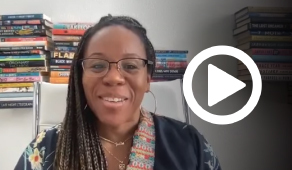
Watch this year’s National NewsLitCamp® event, featuring a special conversation on the legacy of media distrust among communities of color, with Pulitzer-prize winning author and journalist Wesley Lowery, award-winning journalist Natalie Moore and Julia E. Torres, the director of special projects at EduColor.
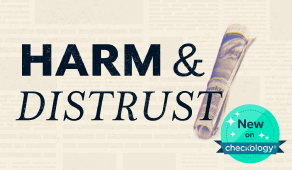
Explore NLP’s new Checkology® lesson designed for educators, called “Harm & Distrust.” It is a master class in how mainstream news organizations have failed to represent Black communities accurately and equitably, and what they are doing about it now.
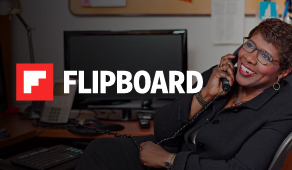
Browse our Flipboard collection on Black History Month, which highlights modern Black journalists’ work and influence in today’s news media landscape.
Thanks to you, our mission to realize a news-literate future continues to grow. Please join us in honoring the contributions of Black Americans this month as we strive to build an equitable information landscape for all.
Making the connection between media literacy and democracy
From the perspective of 2022, Mary Robb and her colleagues look like fortune tellers. Back in 2001 — before 9/11 conspiracy theories, viral memes and QAnon — the educators created a Democracy and Media Literacy course.
“We were teaching civics and figured it made no sense to teach students how to be citizens without teaching them how to navigate the media,” recalled Robb, who teaches social studies at Andover High School in Andover, Massachusetts.
She and her fellow teachers began by giving students a strategy for evaluating the credibility of news and other content borrowed from another colleague, Kathryn Reusch. It’s called WAIL:
- W: for the most powerful words use in an article.
- A: for adjectives and adverbs and what they might indicate about bias.
- I: for the information included.
- L : for the information left out.
“We want to help students become active rather than passive news consumers. What they learn in our class they use every single day,” Robb said.
Senior Nicholas Leonard, who took the class last spring, said learning to analyze news articles has helped him think more critically. “We’d take a story and break it down— right wing, left wing and centrist sources — and then piece the story together to get to the facts. We stripped away the bias.”
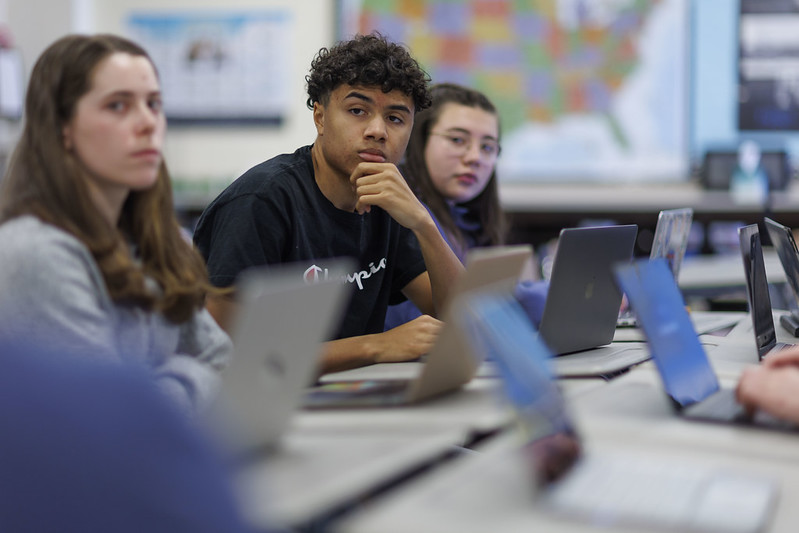 Among the resources Robb and her colleagues use to keep the classwork relevant and engaging is NLP’s free weekly newsletter for educators, The Sift®. “It’s this wonderful, serendipitous situation. We’ll be discussing a topic, say voter fraud, and you’ll have a piece on the topic,” she said. “We’ll use The Sift to understand the necessity to be mindful consumers of news, to pause to think.”
Among the resources Robb and her colleagues use to keep the classwork relevant and engaging is NLP’s free weekly newsletter for educators, The Sift®. “It’s this wonderful, serendipitous situation. We’ll be discussing a topic, say voter fraud, and you’ll have a piece on the topic,” she said. “We’ll use The Sift to understand the necessity to be mindful consumers of news, to pause to think.”
The students go through The Sift item by item, pausing after each one to write down their thoughts. “Now it is second nature. They are much more mindful news consumers,” she said.
Meaningful conversations

Senior Siham Berty took Mary Robb’s Democracy and Media Literacy course last year and said, “she made sure we had access to a wide range of sources, so we always felt like were getting the truth. And we felt like we could voice our opinions.”
Senior Siham Berty took Robb’s class last fall and said she now looks at information differently. “If you asked me a year or two ago, I was 10 times more likely to believe what I saw on social media. Now I take it with pinch of salt. I don’t look at the first thing Google gives me. I go through other news sources.”
One of Berty’s favorite elements of the course was the meaningful interaction with other students. “Her (Robb’s) class really focuses on group discussion. She made sure we had access to a wide range of sources, so we always felt like were getting the truth. And we felt like we could voice our opinions.”
Leonard said that interaction was useful in other ways as well. “I think it really helped in finding common ground. We’d research a story, then break off into groups and come together and talk about it. I think that really helped in promoting compromise and understanding.”
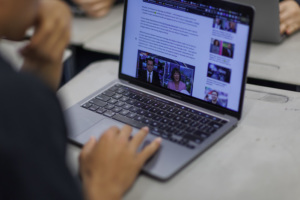 The discussions were vital to understanding the Jan. 6, 2021, uprising at the U.S. Capitol. “We had to talk about it because of all the attempts to spin the events. Some of them (the students) got angry at that,” Robb said.
The discussions were vital to understanding the Jan. 6, 2021, uprising at the U.S. Capitol. “We had to talk about it because of all the attempts to spin the events. Some of them (the students) got angry at that,” Robb said.
She asked students how they heard about the riots and reacted to the news. Then she had students apply the WAIL process to the information they consumed. They realized how different the facts about the event could be, based on the accounts they read. They also broke into groups where students of all political stripes felt comfortable and empowered to speak, Robb said.
To help students understand the impact of social media on their lives, they are asked to take a break from all platforms for one school week. They keep track of what it’s like to be offline each day. Not surprisingly, some feel like they are missing out on what other kids are talking about. But others notice differences in themselves. One student told Robb, “I feel much more calm.” Another said, “I feel more in charge of my thoughts.”
Media literacy and civic engagement
Leonard, who also works as a videographer for the town of Andover recording public meetings and events, considers himself civically engaged. But he said the class strengthened his desire to become even more involved. “I think it made me want to be more engaged. It’s made me aware of people who didn’t have a voice. I want to be politically active and make a difference.”
 By the end of the semester, students have the confidence to share what they’ve learned outside of class. Leonard has done so in conversations with his parents about politics. “They might mention something, and I’ll say, ‘Oh, where did you get that,’ and we will look at it together,” he said.
By the end of the semester, students have the confidence to share what they’ve learned outside of class. Leonard has done so in conversations with his parents about politics. “They might mention something, and I’ll say, ‘Oh, where did you get that,’ and we will look at it together,” he said.
And the learning doesn’t stop at the classroom door. Students get extra credit when they do community service, attend a municipal meeting or volunteer at the polls on Election Day. One year, 30 of Robb’s students volunteered in some form. “They were so passionate,” she said.
That passion for civic responsibility endures. “I’ve gone to vote and seen students I had five or six years earlier. They say, ‘Of course, I vote.’ That is so encouraging,” she said.
NLP’s new framework for teaching news literacy highlighted in The 74
During the third annual National News Literacy Week, NLP unveiled a new framework for teaching news literacy to students. The framework offers standards, questions, objectives, performance tasks and learning activities for educator planning.
As the framework was announced, The 74 spoke with Pamela Brunskill, senior manager of education and content, and Shaelynn Farnsworth, director of educator network expansion, to better understand the framework, its purpose, and why it’s needed now.
Brunskill said the new framework will help teachers manage what feels like unlimited information: “The idea of educating the next generation to be news-literate is daunting, particularly because we’re faced with the most dynamic and complex information environment in history,” she said. “For many educators, it’s hard to know what to teach and where to begin.”
“Instead of developing healthy skepticism, students read with a cynical eye instead of a critical one, often not believing any information they consume online,” Farnsworth said. “To combat this, educators hone skills, so students know what to believe, who to trust and what to share.”
To read the full article, click here.
As a mom and NLP supporter, Wyoming woman values news literacy
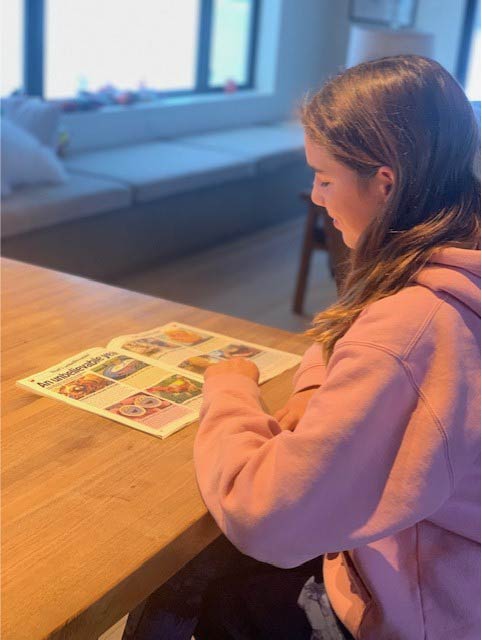
Julia Krugh at her home in Wyoming
In spring 2020, with the world in lockdown and pandemic misinformation surging, Brad and Charlotte Krugh of Jackson, Wyoming, turned to NLP’s Checkology® e-learning platform to augment their older daughter’s distance learning.
Julia, now in eighth grade and attending school in-person, no longer uses NLP resources. But the Krughs remain committed to news literacy education. Charlotte Krugh’s perspective comes from her dual roles as a parent and as an NLP supporter. Her family’s Fore River Foundation is a funder of NLP.
“I really wish more schools would provide these programs. I can talk until I’m blue in the face about it, but when the librarian, the social studies teacher and the language arts teacher say you need to check your sources and verify information, it gets the kids’ attention,” she said.
The Krughs’ younger daughter Eliza, now a sixth grader in middle school, clearly paid attention when peering over Julia’s shoulder. When Eliza is watching TV or online, “she’ll shout out ‘fake news’ whenever she sees anything that’s not true.”
News literacy a family value
Krugh’s family was in the newspaper business, which is why news literacy is a focus of the family foundation. The importance of literacy and access to credible news was instilled early in her and her siblings. “There was a lot of education around how to be a literate human being,” she said, explaining why news literacy is a focus of the family foundation. “It’s one of the ways we want to give back. We really believe that being informed citizens is essential to democracy.”
She doesn’t have to look far to see that people need better access to credible information. While Jackson has a small but well-supported local newspaper, it is the community’s only local news outlet. That’s why some residents turn to social media for their news. “Many older people in this area get all their news from Facebook. We can’t get access to major news sources unless we go online,” she said.
For Krugh, this is a good illustration of why readily accessible news literacy education is needed not only for students in the classroom, but also for adults dealing with a wide range of information sources.
Videos: News literacy’s impact at Iowa high school
Just weeks into the COVID-19 pandemic in April 2020, we spoke with Iowa high school teacher Brian Winkel, who was helping his students navigate a flood of misinformation about the virus. The school had transitioned to distance learning, and Winkel was glad he had already discovered NLP’s Checkology® virtual classroom. A few years earlier, he had developed a course on media awareness called 21st Century Literacy, with the e-learning platform as an essential component of the curriculum. At the time, Winkel told us Checkology was a “godsend.”
Inside an Iowa classroom
Educators and students returned to their classrooms at Cedar Falls High School this school year, and we recently caught up with Winkel and some of his students, creating videos of their lives in and out of school. Winkel told us why he believes news literacy remains so important to his students’ education and to their lives as they enter adulthood. “They have a hard time sorting out the truth,” he said of students when they begin his 21st Century Literacy course. “I do see a change with kids after they come up through this class. I feel like not only am I teaching this class; I’m training kids to make this democracy work.” Hear more about Winkel’s story in the video below.
Student perspectives on news literacy
Seniors Ande McMorris and Colin Seeks might have different interests and world views, but they agree on the value of becoming more news-literate. Ande, captain of the football team, told us he knows there is a great deal of misinformation on social media, and thanks to Winkel’s class, he now understands the harm it can do and is better able to recognize it when he sees it. Watch Ande’s video below to hear his story:
Colin, who loves working on cars, said Winkel’s class introduced him to news literacy concepts, and this has helped him better appreciate his First Amendment rights and the impact that his vote has in a democracy. Watch the video below to hear Colin’s story.
Klaertje Hesselink, who plays violin in the school orchestra and works to raise awareness about climate change, said she learned about the role emotion plays in helping misinformation to spread. Watch Klaertje’s story in the video below.
NLP’s Miriam Romais and KRFC’s ‘Community @ Work’ talk news literacy
At the start of the year, Miriam Romais, NLP’s senior manager of educator engagement, was interviewed by Colorado radio station, KRFC- ‘Community @ Work’ show. The interview covered news literacy broadly, the work being done at NLP, and what steps people can take to become more news literate.
When asked if a lack of news literacy was detrimental to America’s democracy, Romais responded, “I think it is indeed a threat. It’s important to note, everything that we see, that we read, that we hear, is going to affect our thoughts and how we think about things, and therefore our behaviors and our actions. If we’re basing our decisions on faulty information, that can ultimately have adverse effects on our lives. Being able to discern fact from opinion and opinion from fiction is critical because we are living in the most complex information landscape that has ever existed.”
To listen to the full interview, visit KRFC’s website or click here.
Head of education team answers the question, ‘How can you tell if the news you read is real?’
As part of Illinois Public Media’s special week of coverage, “Who’s in charge of the news,” Peter Adams, NLP’s senior vice president of education, helped to empower listeners of The 21st Show with ways to distinguish fact from fiction in the news.
The segment, How can you tell if the news you read is real?, featured Adams along with Stephanie Craft, head of the journalism department at the University of Illinois at Urbana-Champaign, and Michael Spikes, a Ph.D. student in Learning Sciences at Northwestern University.
When asked how to know if a post, meme, or GIF on social media was fact-based and okay to share, Adams said, “When it comes to sharing posts about civic matters, like politics or social issues, it’s best to make sure that what you’re sharing is accurate. If there’s a link to another source involved, make sure it’s a standards-based source that has processes of verification in place and strives to be as fair and accurate as possible in the information it produces. I would add that lots of people, including people who we love and generally trust in our lives, share or reshare false claims. Sometimes these are just statements, what we call, ‘sheer assertions,’ with no evidence at all. But sometimes these kinds of baseless claims can take other forms. So, a photo without attribution or context, or a screenshot of a headline with no link, or a meme.”
To listen in full, click here. (Adams is quoted at the 7:40 and 16:00 minute marks.)
October 28: Tips and Tricks for Integrating News Literacy in the 6-12 Classroom

Please join us on Thursday, Oct. 28 for an important, free, day-long event, Summit: In Community, hosted by the School Library Journal (SLJ). The virtual summit seeks to highlight that community can mean a lot of things, beyond only geography. We all work and live in the context of community, and our interdependence has never been made more apparent than in our shared experience of the pandemic.
Shaelynn Farnsworth, director of network expansion at the News Literacy Project (NLP), and Kelly Vikstrom-Hoyt, director of library services at The Overlake School in Redmond, Washington, and NLP’s 2021 News Literacy Educator of the Year, will present during the summit. “Tips and Tricks for Integrating News Literacy in the 6-12 Classroom” will underscore why it is essential for students to determine fact from fiction, fight misinformation and have the abilities needed to be smart, active consumers of news and information and equal and engaged participants in a democracy. Presenters will share various free, ready-made classroom resources and programs that all educators can use in a short lesson or an extended unit.
Join this session to learn practical, hands-on ways to teach news literacy skills to your students. To learn more and register, click here.
Please note that the event environment and the sessions have attendance capacity limits. If on the day of the event you find that you are unable to access the environment or join a session, please know that sessions will be available for on-demand viewing within 24 hours, and the entire event will be accessible for three months from the event date.
Teaching news literacy in polarizing times
By Hannah Covington and Suzannah Gonzales
While discussing the Derek Chauvin murder trial in the death of George Floyd, a student alerts the class about the fatal shooting of Daunte Wright. On a separate day, another student asks why there was little coverage about a certain aspect of the deadly Atlanta-area shootings. The morning after a grand jury’s September decision in the Breonna Taylor case, a student wants to talk about it. Others bring up national politics.
In a school year of historic upheaval, partisanship and vitriol can easily seep into the classroom when controversial current events come up. Faced with charged students — as well as parents and guardians — some educators may question whether it is worth broaching these difficult topics at all.
But teaching current events through the lens of news literacy can help students engage meaningfully with the headlines they encounter without exacerbating strong emotions or divisions — and also empower them to identify credible news and information. Below are six tips and strategies for teaching news literacy in polarizing times.
1. Approach news reports like other texts
News coverage — like poetry, short stories and other class texts — offers rich opportunities for discussion and analysis. Remind students to approach news stories as they would other texts in class: closely and critically, evaluating each piece of information and any supporting evidence. If a student makes a polarized claim during class or in an assignment, challenge them to support the claim with fact-based evidence.
2. Focus on journalism standards
Center discussions of news articles on the standards of quality journalism, which can help build common ground. Even those who disagree on controversial issues can agree that credible news coverage should incorporate standards, such as fairness, accuracy and transparency.
For instance, asking students to read a news article with credible sources in mind — “Where is information coming from? How many different sources are there? Are any relevant voices or perspectives missing?” — can sharpen the focus of a class conversation and help move students beyond kneejerk reactions to a story topic.
3. Emphasize specifics
Rather than labeling an entire news report as “biased,” students should concentrate on particulars, such as a specific headline, caption or word choice. Pose questions like, “Is this specific element of the story fair and accurate?” or, “If you had to write a headline for this story, what would it be?”
Students, for example, could compare wording in breaking news alerts about the decision in the Breonna Taylor case. Or, they could focus on how news organizations label coverage of major developing stories, such as the deadly Atlanta-area spa shootings.
Focusing the conversation on specific parts of news coverage may help avoid fights over the topic itself.
4. Reflect on personal biases
Students benefit from becoming aware of their own biases as news consumers. Personal backgrounds and life experiences — as well as factors like race, ethnicity and gender — shape how we see the world. Ask students to consider how these biases might affect their perceptions of news reports and opinion pieces.
Following the Atlanta-area shootings, for example, students could read guidance published by the Asian American Journalists Association (AAJA) for newsrooms reporting on the shootings. Then, they could review news coverage and see how it compares to AAJA’s recommendations, taking note of language choices, context and sources.
5. Consult diverse news sources
Encourage students to explore various points of view by diversifying their media diet and turning to credible news sources that take journalism standards and ethics seriously. It’s easy to fall into partisan news bubbles, especially on social media. Challenge them to seek out multiple sources and perspectives — not just the ones they typically consult and agree with or that confirm their existing views. Being open to opposing viewpoints can help combat polarization.
Coverage comparisons, including headlines, work especially well: How did different news organizations cover this same topic? What similarities or differences do you notice?
One way to discuss the Chauvin case, for instance, could involve comparing coverage from local, national and international news organizations.
6. Remember learning outcomes
News literacy can give students practice using critical reading and observation skills. It aims to teach students how to think — not what to think — about news and other information (including sensitive issues). And with so many recent breaking and controversial news events that affect students and their communities, learning outcomes for news literacy apply well beyond the classroom.
* * *
Journalism documents today’s history. The unprecedented events and major news of the last school year have made teaching news literacy more crucial than ever. The current polarized climate may raise concerns over angry students, parents and guardians, but it also can present opportunities for productive dialogue. While recent events and controversies may feel overwhelming to teach, incorporating news literacy alongside a few simple strategies can help address important stories of the moment while making classroom conversations worthwhile.
Hannah Covington is the senior manager of education and content at the News Literacy Project. Suzannah Gonzales is a university adjunct instructor and former director of education and content at the News Literacy Project.
Strategies for savvy news consumers
In part one of a two-part series for the Education for Sustainable Democracy podcast, John Silva, NLP’s senior director of education and training, and Miriam Romais, NLP’s senior manager of educator engagement, discussed the importance of news literacy and strategies to help young people become smart news consumers.
“We have the assumption that because students are digital natives, they aren’t digitally naïve,” Romais said. But young people don’t always know how to tell the difference between social media posts that are misleading, and ones that are credible. “If you’re basing all of your decisions, actions, and emotions on something that is false, how do you move through life? So, we try to get to the point where we help the educators and the general public [with news literacy skills], and educators specifically because they’re going to amplify this to their students.”
Silva, a former educator who taught for 13 years in Chicago Public Schools, said integrating news literacy into the classroom strengthens the overall curriculum. “As a history teacher, as a social studies teacher, we are continually talking about, ‘How do we know what happened? What are the sources we can go to in order to know the who, the why, the where, and the when?’ News literacy helps provide a different understanding of journalism, because that… is what reporters are doing, they’re telling us what happened – the who, the what, the where, the when. There’s a famous quote, ‘Journalism is the first draft of history,’ and understanding how to evaluate that, in the modern sense, helps to understand history, but it also helps when we’re talking about current events and things that are happening in civics.”
You can listen to all of part one of the podcast here.
Young people have a right to news literacy – MinnPost
NLP’s John Silva explained in a piece for the nonprofit news site MinnPost why news literacy education must be integrated into K-12 education across all subject areas and grade levels and be mandated as a high school graduation requirement.
“Adults struggle to navigate this overload of information, yet we assume young people, incorrectly called ‘digital natives,’ somehow know how to do so from birth. The fact is, no one is born with innate technology skills; they must be taught and reinforced through practice. We are failing young people by not preparing them for the problematic information ecosystem they are growing up with and inheriting,” Silva wrote. “This is why young people have a right to news literacy.”
This piece ran in MinnPost’s Community Voices section in advance of NLP’s June 15 NewsLitCamp® with the Star Tribune and Minnesota Public Radio. Silva is NLP’s senior director of education and training.